Independent musicians can boost their income through effective merchandising strategies. Key approaches include creating unique merchandise, leveraging e-commerce platforms, and engaging fans with personalized experiences. Pricing strategies and innovative revenue streams further enhance sales potential. Measuring success through sales data and social media engagement helps refine these strategies for maximum impact.
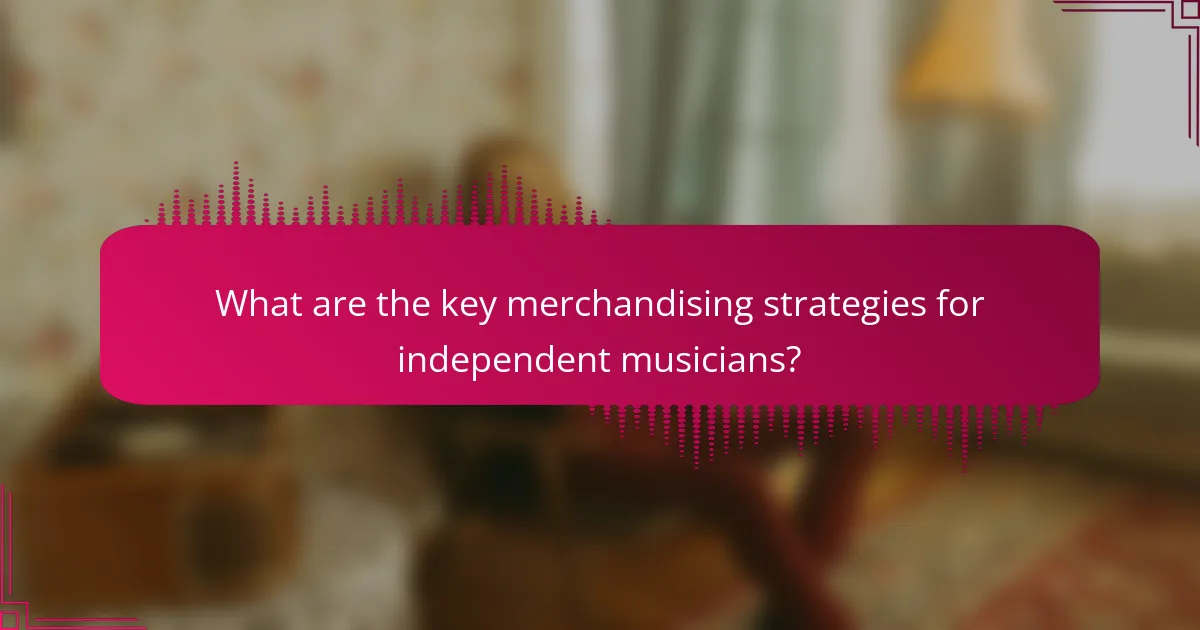
What are the key merchandising strategies for independent musicians?
Independent musicians can enhance revenue through diverse merchandising strategies. Key approaches include creating unique merchandise, leveraging online platforms, and engaging fans through personalized experiences.
Offering exclusive items like limited-edition vinyl or branded apparel fosters a strong connection with fans. Utilizing e-commerce sites allows musicians to reach a broader audience and manage sales efficiently. Additionally, hosting pop-up shops or virtual events can create memorable interactions, driving merchandise sales while deepening fan loyalty.
Implementing these strategies not only generates income but also strengthens the musician’s brand identity in a competitive market.
How can independent musicians leverage online platforms for merchandise sales?
Independent musicians can effectively leverage online platforms for merchandise sales by utilizing social media, e-commerce sites, and crowdfunding platforms. These channels allow musicians to reach wider audiences and create unique brand experiences.
Social media platforms like Instagram and Facebook enable direct engagement with fans, showcasing merchandise through posts and stories. E-commerce websites such as Shopify or Bandcamp provide streamlined purchasing experiences, while crowdfunding platforms like Patreon allow for exclusive merchandise offerings to loyal supporters.
Additionally, musicians can enhance their merchandise appeal by offering limited edition items, bundling products, and collaborating with artists for unique designs. This strategy not only boosts sales but also strengthens fan loyalty and community engagement.
Overall, embracing these online platforms and strategies maximizes revenue potential and fosters a deeper connection with the audience.
What role does branding play in merchandising for musicians?
Branding is crucial in merchandising for musicians as it creates a distinct identity and fosters fan loyalty. Effective branding enhances merchandise appeal, allowing musicians to connect emotionally with their audience. This connection can lead to increased sales and diversified revenue streams. Unique merchandise, reflecting the artist’s brand, can attract fans and differentiate them in a competitive market. Additionally, consistent branding across products reinforces recognition and trust, encouraging repeat purchases.
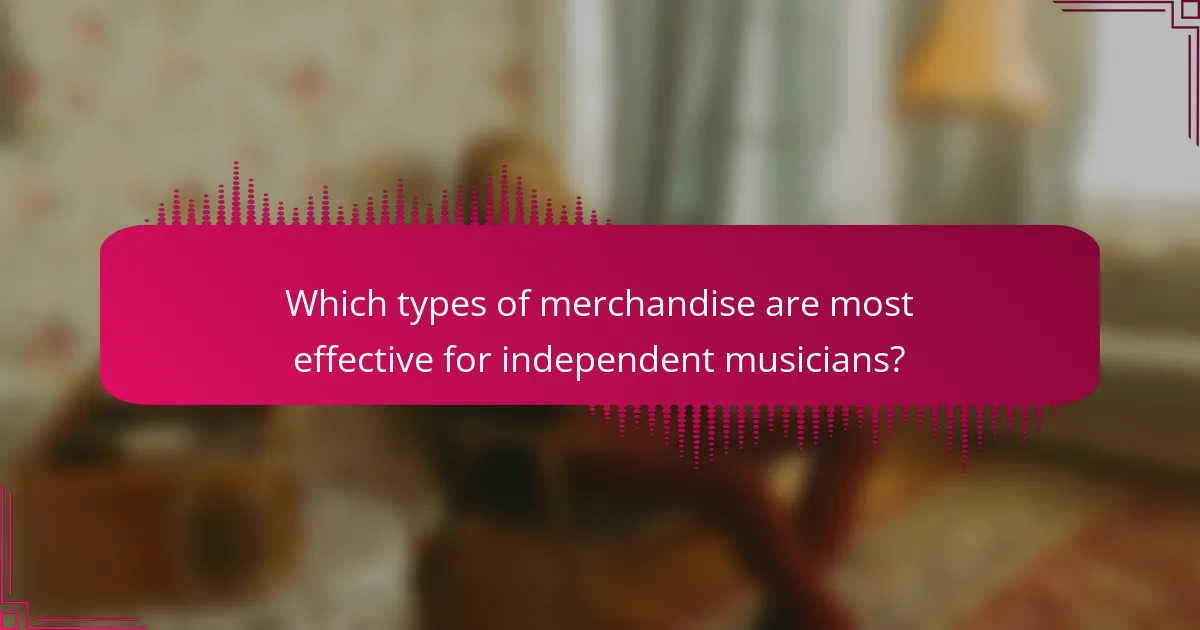
Which types of merchandise are most effective for independent musicians?
Independent musicians can effectively use merchandise such as apparel, physical albums, digital downloads, accessories, and exclusive content. These items enhance fan engagement and generate revenue streams.
Apparel like T-shirts and hoodies create brand visibility. Physical albums provide tangible connections to music. Digital downloads offer convenience and immediate access. Accessories, such as stickers and pins, are affordable and collectible. Exclusive content, like behind-the-scenes videos or limited editions, fosters loyalty among fans.
By diversifying merchandise types, independent musicians can cater to various fan preferences and maximize sales potential.
What are the benefits of physical merchandise versus digital products?
Physical merchandise offers tangible value and unique experiences that digital products cannot replicate. Merchandise fosters deeper connections with fans through physical presence and brand loyalty.
Physical items, like vinyl records or branded apparel, create lasting memories and emotional attachments. They serve as collectibles, enhancing perceived value. Additionally, merchandise can generate higher profit margins compared to digital products, as production costs can be managed effectively.
Conversely, digital products provide instant access and lower overhead costs. However, the unique attributes of physical merchandise often lead to more robust revenue streams for independent musicians. Engaging fans through exclusive merchandise can enhance brand identity and increase overall sales.
How can musicians create unique merchandise that stands out?
Musicians can create unique merchandise by focusing on personalized designs, sustainable materials, and limited editions. These strategies enhance brand identity and customer loyalty.
Personalized merchandise, such as custom apparel or accessories featuring fan names, fosters connection. Sustainable options, like eco-friendly products, appeal to environmentally conscious consumers. Limited edition items create urgency and exclusivity, driving sales.
Engaging with fans through social media can also inspire merchandise ideas. Polls or contests can help identify what fans want, ensuring offerings resonate with the audience.
Incorporating local art or collaborating with other artists can differentiate merchandise further, enhancing its uniqueness. These approaches not only generate revenue but also strengthen the artist’s brand.
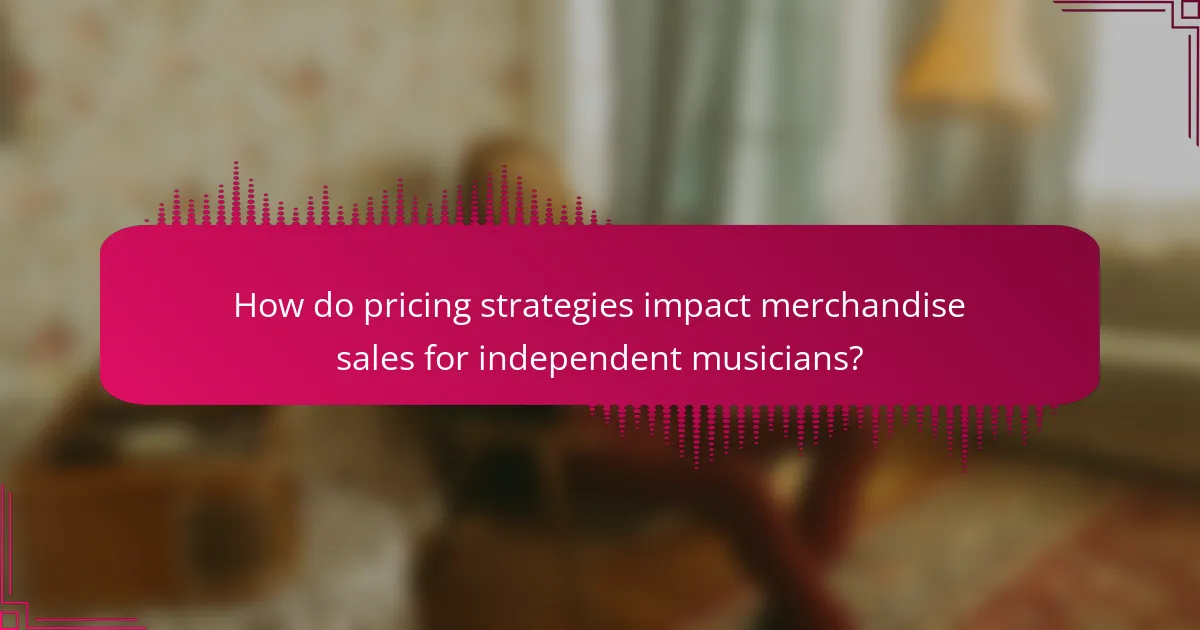
How do pricing strategies impact merchandise sales for independent musicians?
Pricing strategies significantly influence merchandise sales for independent musicians by affecting perceived value and consumer demand. Competitive pricing can attract more buyers, while premium pricing can enhance brand image. Limited-time offers or bundles can create urgency, encouraging purchases. Understanding the target audience’s willingness to pay is crucial for optimizing pricing. Implementing tiered pricing can also accommodate various fan budgets, maximizing revenue potential.
What factors should musicians consider when setting prices for their merchandise?
Musicians should consider production costs, target audience, market trends, and perceived value when setting merchandise prices. Production costs directly impact profitability, while understanding the target audience helps tailor pricing strategies. Market trends can inform competitive pricing, and perceived value influences how customers view the merchandise’s worth. Balancing these factors ensures sustainable revenue streams.
How can bundling products enhance revenue streams?
Bundling products can significantly enhance revenue streams for independent musicians. By offering combined merchandise, musicians create greater perceived value, encouraging fans to purchase more items at once.
For example, a bundle might include a digital album, a physical CD, and exclusive merchandise like a T-shirt or poster. This strategy not only increases the average transaction value but also builds a stronger connection with fans through unique offerings.
Moreover, bundling can reduce marketing costs by promoting multiple items together, streamlining promotional efforts. This approach taps into the unique attribute of fan loyalty, as supporters are often willing to invest in comprehensive packages that represent their connection to the artist.
Ultimately, effective bundling can lead to improved sales performance, customer satisfaction, and brand loyalty, creating a sustainable revenue model for independent musicians.
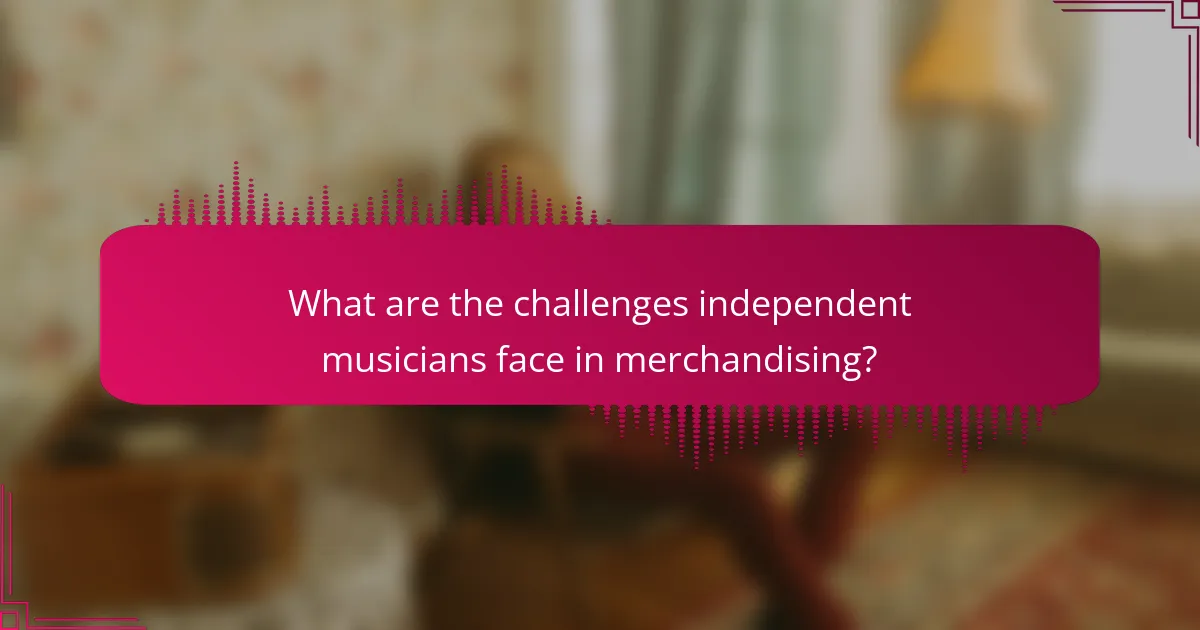
What are the challenges independent musicians face in merchandising?
Independent musicians face several challenges in merchandising that impact revenue generation. Limited budgets restrict inventory investment and marketing efforts. Competition from established artists makes visibility difficult. Additionally, lack of industry knowledge hinders effective strategy development. Online platforms can be overwhelming, complicating sales processes. Lastly, managing logistics and fulfillment can strain resources.
How can musicians overcome production and distribution hurdles?
Independent musicians can overcome production and distribution hurdles by leveraging innovative merchandising strategies. These strategies include creating unique merchandise, utilizing online platforms for sales, and engaging directly with fans.
Developing custom merchandise such as apparel, accessories, or limited edition items can enhance brand identity and generate additional revenue streams. Utilizing e-commerce platforms allows musicians to reach a wider audience without the need for physical distribution. Engaging fans through social media and crowdfunding can also provide financial support for production costs.
By focusing on these merchandising strategies, independent musicians can effectively navigate production and distribution challenges, ensuring greater financial stability and audience connection.
What common mistakes do musicians make with their merchandise strategies?
Musicians often make several common mistakes with their merchandise strategies. They frequently underestimate the importance of branding, leading to inconsistent merchandise that does not resonate with their audience. Another mistake is neglecting online sales channels, which limits revenue potential. Additionally, poor inventory management can result in overstock or stockouts, impacting sales. Finally, failing to engage with fans about merchandise can diminish interest and sales opportunities.

How can independent musicians utilize social media for merchandising success?
Independent musicians can leverage social media to enhance merchandising success by engaging their audience directly. They should create visually appealing posts showcasing merchandise, utilize stories for limited-time offers, and collaborate with influencers to expand reach.
Additionally, musicians can host live streaming sessions to promote their products and offer exclusive discounts to followers. Engaging content, such as behind-the-scenes glimpses and fan interactions, can further enhance connection and drive sales. Effective use of hashtags can increase visibility and attract potential buyers.
Which social media platforms are most effective for promoting merchandise?
Instagram, TikTok, and Facebook are the most effective social media platforms for promoting merchandise. Instagram’s visual appeal engages users, while TikTok’s short videos allow for creative promotion. Facebook’s extensive reach facilitates targeted advertising. Each platform offers unique attributes that cater to independent musicians’ merchandising strategies.
How can musicians engage their audience to drive merchandise sales?
Musicians can engage their audience effectively by leveraging social media, offering exclusive merchandise, and creating immersive experiences. These strategies enhance connection and drive merchandise sales.
Social media platforms enable musicians to share behind-the-scenes content, fostering a personal bond with fans. Exclusive merchandise, such as limited edition items, creates urgency and encourages fans to purchase. Additionally, hosting events or pop-up shops where fans can interact directly with musicians enhances the overall experience and boosts sales.
As a result, these engagement strategies not only strengthen fan loyalty but also increase revenue streams for independent musicians.
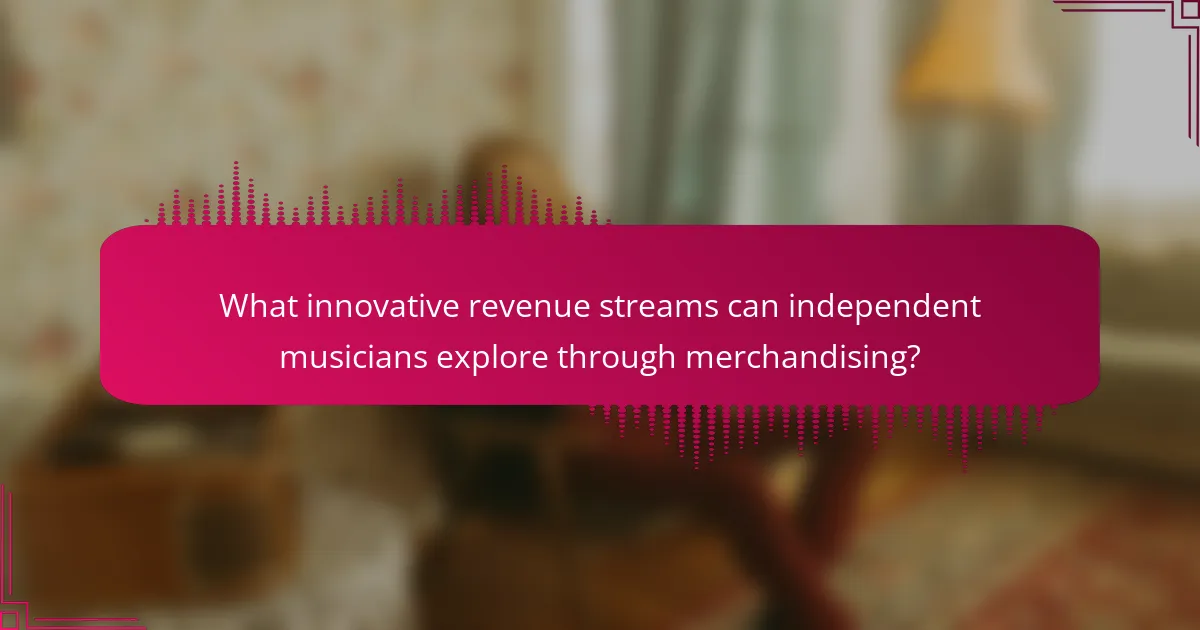
What innovative revenue streams can independent musicians explore through merchandising?
Independent musicians can explore various innovative revenue streams through merchandising, enhancing their income and fan engagement. Unique merchandise items, such as custom apparel, limited edition vinyl records, or art prints, can attract dedicated fans. Additionally, incorporating digital products like exclusive music downloads or virtual concert tickets can diversify revenue. Collaborations with local artists for unique designs can also create a sense of community and exclusivity. Subscription models for merchandise delivery can provide steady income while keeping fans engaged with regular updates.
How can musicians incorporate limited edition items to create exclusivity?
Musicians can create exclusivity by offering limited edition items that resonate with their audience. These items can include unique merchandise, such as vinyl records, signed posters, or exclusive apparel. By limiting the quantity and emphasizing their rarity, musicians enhance perceived value and desirability. This strategy not only boosts sales but also fosters a deeper connection with fans. Engaging storytelling around these items can further amplify their appeal, making fans feel part of a special community.
What role do collaborations play in expanding merchandise offerings?
Collaborations significantly enhance merchandise offerings for independent musicians. By partnering with other artists, brands, or influencers, musicians can access new audiences and diversify their product lines. Collaborations allow for unique merchandise, such as limited-edition items or co-branded products, which can attract collectors and fans alike. This strategy not only boosts sales but also strengthens brand visibility and loyalty among diverse fanbases.
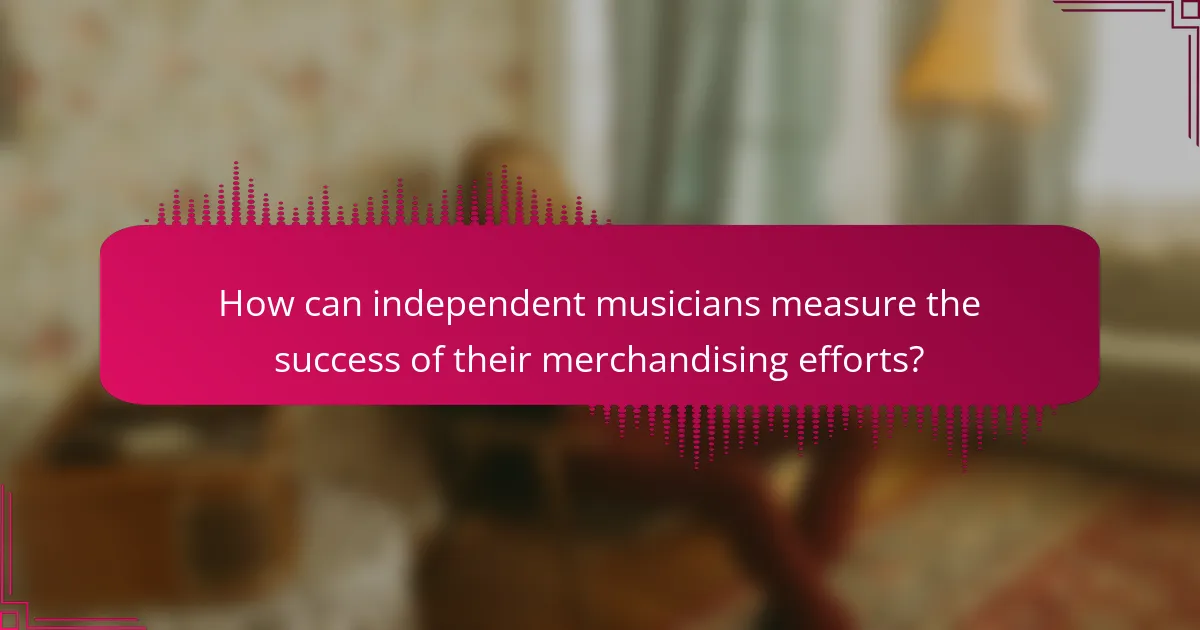
How can independent musicians measure the success of their merchandising efforts?
Independent musicians can measure merchandising success through sales data, customer feedback, and social media engagement. Analyzing sales figures provides direct revenue insights. Customer feedback reveals product appeal and areas for improvement. Social media engagement indicates brand reach and fan connection. Tracking these metrics over time helps refine strategies and maximize revenue.
What metrics should musicians track to evaluate merchandise performance?
Musicians should track sales volume, revenue generated, profit margins, inventory turnover, customer demographics, and online engagement metrics to evaluate merchandise performance. These metrics provide insight into what products resonate with fans and optimize revenue streams.
| Metric | Description |
|————————-|—————————————————–|
| Sales Volume | Total units sold over a specific period |
| Revenue Generated | Total income from merchandise sales |
| Profit Margins | Difference between sales revenue and costs |
| Inventory Turnover | Rate at which merchandise is sold and replaced |
| Customer Demographics | Data on buyer characteristics and preferences |
| Online Engagement Metrics| Interaction levels on social media and web stores |
How can feedback from fans inform future merchandise strategies?
Feedback from fans can significantly shape future merchandise strategies by aligning products with audience preferences. Engaging with fans through surveys and social media helps identify popular items and trends. This data not only informs product design but also enhances marketing efforts. For instance, musicians can create limited-edition merchandise based on fan input, fostering loyalty and increasing sales. Ultimately, leveraging fan feedback leads to more targeted and successful merchandise offerings.
What are the best practices for optimizing merchandise sales?
To optimize merchandise sales, independent musicians should focus on targeted marketing, unique product offerings, and effective online platforms. Utilize social media to engage fans and promote exclusive items, such as limited-edition merchandise. Create bundles that combine music and merchandise for added value. Leverage email marketing to inform fans about new releases and special promotions. Consider pop-up shops or collaborations with local businesses to expand reach.



